Software Survey: Readers embrace software’s leading role in warehousing and distribution
As the complexities of modern-day fulfillment continue to grow, software is playing an increasingly important role in how companies manage in this dynamic environment.
As warehouses and DCs become more automated and less reliant on human labor, and as that labor gets harder to come by and more expensive, the software supporting these operations is in high demand.
From the warehouse management system (WMS) that more effectively manages inventory to the warehouse control system (WCS) that directs real-time activities within the DC to the yard management system (YMS) that coordinates the movement of vehicles out in the yard, software increasingly provides the platform through which most fulfillment and distribution activities are orchestrated.
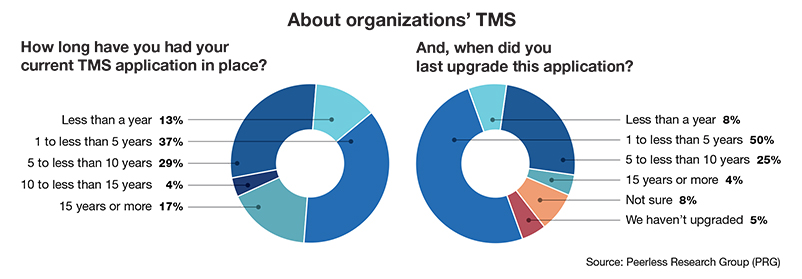
Modern Materials Handling’s “2019 Materials Handling Technology Study” supports this assumption and reveals the leading role that software is playing in warehouses and DCs nationwide. For this year’s Peerless Research Group (PRG) survey of Modern subscribers, respondents shared their views of current software usage, returns on investment, and key goals related to their software purchases.
Of the 108 readers who participated in the study, 18% are corporate/divisional managers, 23% are vice presidents/general managers, and 11% are logistics/distribution managers.
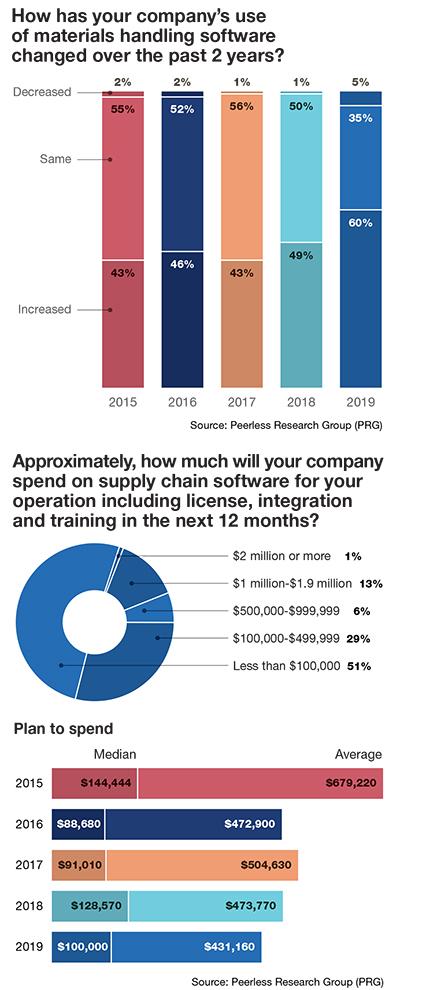 Twenty-two percent of respondents work for companies with less than $10 million in sales and 19% are with firms that have $10 million to $49.9 million in annual sales. The bulk of respondents (32%) work for manufacturing firms, while 24% are with wholesalers, and 12% are employed by companies operating in the transportation and warehousing services sector.
Twenty-two percent of respondents work for companies with less than $10 million in sales and 19% are with firms that have $10 million to $49.9 million in annual sales. The bulk of respondents (32%) work for manufacturing firms, while 24% are with wholesalers, and 12% are employed by companies operating in the transportation and warehousing services sector.
60% and counting
Few would argue the importance of robust, reliable software platforms in today’s e-commerce, omni-channel warehouses. According to this year’s survey, 60% of companies are using more materials handling software than they did just two years ago (up from 49% in 2018). Forty-nine percent of firms say their use has stayed the same (down from 50% last year) and just 5% say they’re using less software than they did in 2017.
Of the various types of software designed to streamline warehousing operations, most companies (67%) rely on WMS, while 33% use supply chain management and planning platforms (up from 15% in 2018). And, 26% of survey respondents have implemented transportation management systems (TMS)—a drop from 38% in 2018. Labor management software (LMS) is also seeing lower usage rates, with just 17% using these platforms now, compared to 32% in 2018.
When asked how much money their companies plan to spend on supply chain software (including license, integration and training) over the next 12 months, 51% of readers pinpoint that number at about $100,000. Twenty-nine percent will spend between $100,000 and $499,999; 6% say $500,000-$999,999; and 13% will spend $1 million to $1.9 million. And, 1% of firms plan to spend more than $2 million on supply chain software in 2019.
This brings the average spend for 2019 to $431,160 (down from $473,770 in 2018) and the 2019 median spend to $100,000 (versus $128,570 last year). These purchase expectations have slowly trended downward since 2015 (with the exception of 2017, when tech investment increased), likely because many companies now have the core technology in place to at least run baseline operations.
Older systems still work
In reviewing this year’s software survey results, Ian Hobkirk, president at Boston-based Commonwealth Supply Chain Advisors, didn’t pick up on anything “unusual or out of whack” with the findings. Zeroing in on the questions that asked how long companies have had their WMS and TMS applications in place, he says there’s a clear divide between companies that have just put their systems in place and those that are still using 15- to 20-year-old platforms.
“That’s not going to change anytime soon,” says Hobkirk. According to the survey, 8% of respondents have had their WMS applications in place for a year or less, while 33% have been using their systems for five years or less. That means 41% of all readers have WMS platforms that are less than five years old. At the other end of the spectrum, 20% rely on WMS solutions that were installed more than 15 years ago.
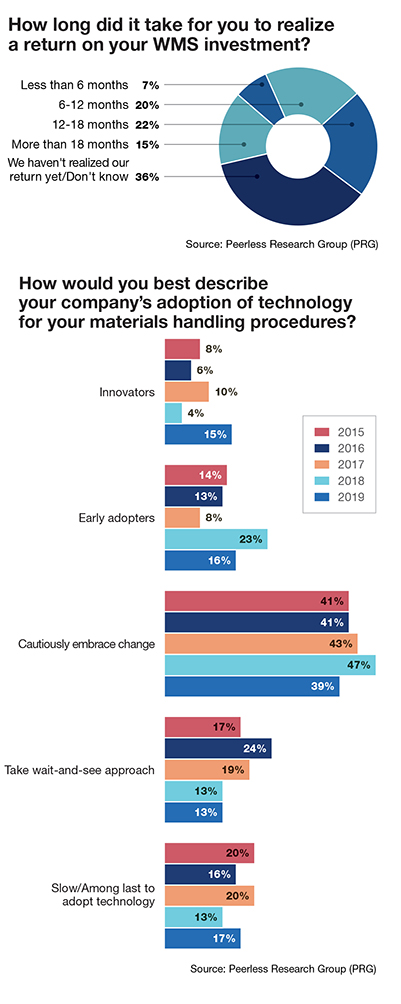 Asked how long their current TMS solutions have been in place, 13% of readers say less than a year and 37% have been using their systems for 1 to 5 years. Seventeen percent of companies have had their TMS platforms in place for 15+ years. “You don’t see a lot of companies replacing systems they installed 15 years ago, but according to the survey, a good portion of them have replaced the ones they had in place for less than 10 years,” says Hobkirk. “That’s a pretty interesting trend that’s probably not going to change anytime soon.”
Asked how long their current TMS solutions have been in place, 13% of readers say less than a year and 37% have been using their systems for 1 to 5 years. Seventeen percent of companies have had their TMS platforms in place for 15+ years. “You don’t see a lot of companies replacing systems they installed 15 years ago, but according to the survey, a good portion of them have replaced the ones they had in place for less than 10 years,” says Hobkirk. “That’s a pretty interesting trend that’s probably not going to change anytime soon.”
Where’s the ROI?
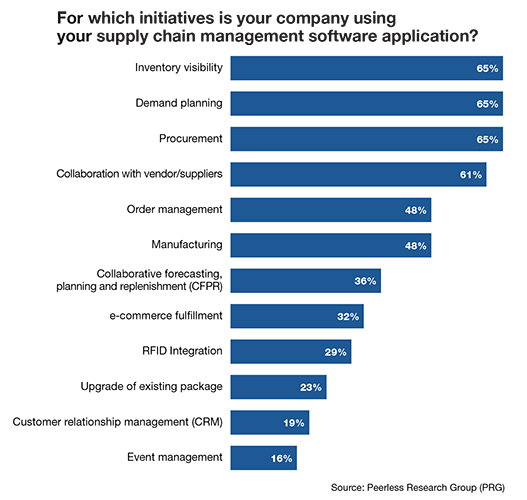 For many companies (36%), return on investment for WMS software is a nebulous benchmark that they either haven’t realized yet or simply aren’t keeping track of. Twenty-two percent of readers say they realized a return on their WMS investments within 12 to 18 months, while 20% say 6 to 12 months.
For many companies (36%), return on investment for WMS software is a nebulous benchmark that they either haven’t realized yet or simply aren’t keeping track of. Twenty-two percent of readers say they realized a return on their WMS investments within 12 to 18 months, while 20% say 6 to 12 months.
For TMS, 21% of readers surveyed say they haven’t realized their return on investment for their software yet, or that they don’t know whether they have or not. Twenty-five percent saw an ROI for TMS of 12 to 18 months, while 25% say it took 6 to 12 months.
Hobkirk says these results validate what most of the industry already knows: that there’s faster ROI in TMS compared to WMS. “TMS tends to be less risky and less disruptive for companies to implement,” he says. “You’re seeing a faster ROI there that is completely believable, and that’s primarily because TMS lends itself better to the Cloud-based model.”
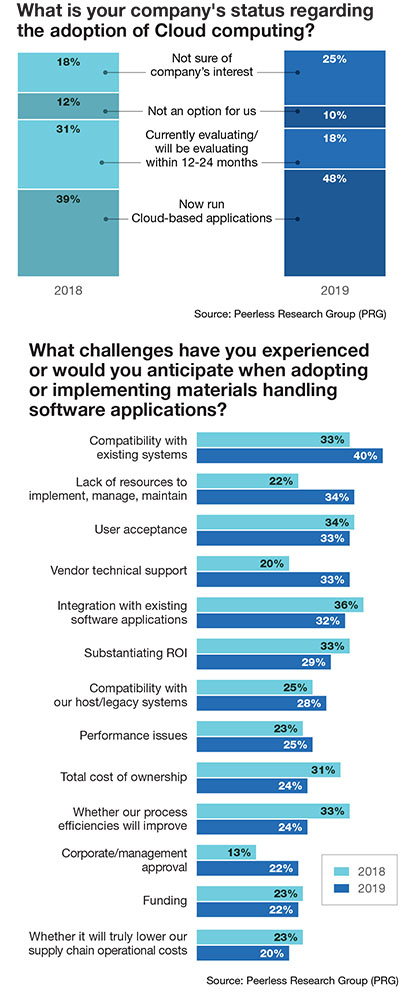 Looking at materials handling technology as a whole, Hobkirk says the study reveals a reader base that’s willing to make investments to meet customers’ demands and to continue growing. This year, for example, 15% of companies label themselves as “innovators” and 16% call themselves “early adopters.” Another 39% are cautiously embracing change, while 13% are taking a “wait-and-see” approach to technology.
Looking at materials handling technology as a whole, Hobkirk says the study reveals a reader base that’s willing to make investments to meet customers’ demands and to continue growing. This year, for example, 15% of companies label themselves as “innovators” and 16% call themselves “early adopters.” Another 39% are cautiously embracing change, while 13% are taking a “wait-and-see” approach to technology.
“There’s a lot of new technology out there right now,” says Hobkirk, “versus, say, 10 years ago, when I really wasn’t impressed with the pace of innovation.” He points to mobile autonomous robots, AutoStore, and other goods-to-person picking systems as just a few of the innovations that companies are starting to think about. “They’re neat concepts,” he says, “and people are fascinated by them.”
According to the survey, 13% of companies are using Big Data, while 11% are evaluating or considering it. And, 10% are using artificial intelligence (AI) in their operations; 17% have deployed Internet of Things (IoT) technology; 7% are using blockchain in their operations; and 9% are using machine learning (ML).
Hobkirk, who works closely with warehouse and DC managers to implement technology to streamline their operations, says very few are adopting advanced options like AI, IoT, robotics and ML. “I’ve probably had one blockchain conversation in the last 18 months,” says Hobkirk. “It’s not that blockchain isn’t valuable, it’s just that for the most part it’s not on our radar yet.”
In the Cloud
With Cloud computing gaining momentum in the supply chain management space, 48% of readers say they’re running Cloud-based materials handling applications (up from 39% in 2018). And, 18% are currently evaluating (or will be evaluating) Cloud-based applications over the next 12 to 24 months, and 10% say it’s not an option for their companies.
The biggest increase in Cloud-based adoption occurred with WMS, TMS, labor management systems (LMS) and slotting. Usage of Cloud-based order management or planning is at 64% for 2019, up from 48% last year.
According to the survey, 23% of readers are considering applications that manage or collect data on lift truck fleets, while 34% are interested in applications that monitor systems, manage information or predict system failures for their automated warehouse equipment.
What users want
 From their supply chain management software, most companies are looking for inventory visibility (65%), demand planning (65%), procurement (65%) and better collaboration with vendor/suppliers (61%). Other goals include better order management, more streamlined manufacturing processes, and more collaborative forecasting, planning and replenishment.
From their supply chain management software, most companies are looking for inventory visibility (65%), demand planning (65%), procurement (65%) and better collaboration with vendor/suppliers (61%). Other goals include better order management, more streamlined manufacturing processes, and more collaborative forecasting, planning and replenishment.
When asked what obstacles they’ve faced when adopting materials handling software, 40% of companies say their top concern is compatibility with existing systems (compared to 33% last year). Thirty-four percent cite a lack of resources to implement, manage and maintain as their biggest issue, while 33% say user acceptance is a key challenge. Other concerns include integration with existing software applications (32%), sustaining ROI (29%), compatibility with host/legacy systems (28%) and performance issues (25%).
“Lack of resources to implement is really much more pronounced today than it has been in the last couple of years,” Hobkirk says. “From a staffing perspective, everybody’s hiring and fighting over the same people. It’s a good time to be looking for a job.”
Looking ahead, Hobkirk says that as e-commerce becomes a bigger and more prevalent force, more companies will be looking to incorporate packing technology into their warehouses and DCs. “Too often, companies focus on improving the picking process while ignoring the packing process, and the labor that’s being allocated to it,” says Hobkirk. “Cartonization, picking directly to the shipping container, and motion weight scales just don’t get as much discussion, but they can all produce just as good of an ROI—or better—than simply fixing the picking process.”

Article Topics
Software News & Resources
C-suite Interview with Keith Moore, CEO, AutoScheduler.AI: MODEX was a meeting place for innovation C-Suite Interview with Frank Jewell of Datex, Leading the Way in the Material Handling Industry Give your warehouse management systems (WMS) a boost Agility Robotics and Manhattan Associates partner to bring AI-powered humanoid robots into warehouses Siemens, Universal Robots, and Zivid partner to unveil smart robotic picking solution OTTO Motors showcases latest software release for optimizing floor space Rite-Hite ONE digital platform debuts More SoftwareLatest in Materials Handling
NetLogistik partners with Vuzix subsidiary Moviynt to offer mobility solutions for warehouses Materials Handling Robotics: The new world of heterogeneous robotic integration Lucas Watson appointed CSO for Körber’s Parcel Logistics business in North America Hyster recognizes Dealers of Distinction for 2023 Carolina Handling names Joe Perkins as COO C-suite Interview with Keith Moore, CEO, AutoScheduler.AI: MODEX was a meeting place for innovation Walmart deploying autonomous lift trucks at four of its high-tech DCs More Materials HandlingAbout the Author
Subscribe to Materials Handling Magazine

Find out what the world's most innovative companies are doing to improve productivity in their plants and distribution centers.
Start your FREE subscription today.
April 2024 Modern Materials Handling

Latest Resources












